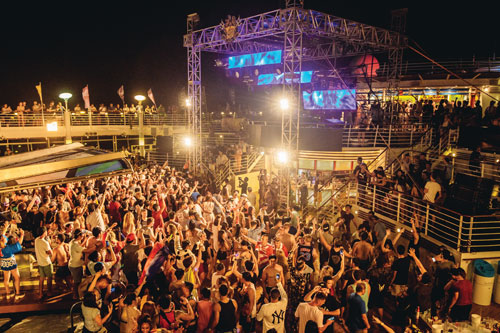Cruise lines are doing more to change Asian millennials’ mindset of cruising from ‘what my parents and grandparents do’, to a vacation alternative they too desire to have.

Photos by Colossal Photos and All is Amazing
It was an unusual sight – 3,800 passengers almost all under the age of 30 onboard the Mariner of the Seas last November for a three-night cruise. Their main attraction? The Electronic Dance Music (EDM), Asia’s largest music festival at sea since its inception in 2014.
It’s The Ship transformed the Royal Caribbean vessel into a non-stop heart thumping dance floor. Parties went on from dawn to dusk everywhere on the ship, from the main deck with its hot tubs and pools, to the bars, clubs and lounges.
This hedonistic floating music festival is a way cruise lines are changing the mindset of millennials that cruising is only for the rich or their parents’ generation. Royal Caribbean’s managing director, Singapore and South-east Asia, Sean Treacy, said millennials comprise about 20 per cent of the cruise line’s guests in the region.
“Many young people in Asia have never cruised before or have only done so once or a few times in their childhood, so their idea of cruising can be rather outdated and limited. It’s no surprise that a lot of them do not find cruising appealing.” Hence, said Treacy, there is a huge opportunity to grow the pie.
Events like It’s The Ship and other music-themed cruises lure the younger generation. Treacy pointed out the enormous publicity generated, especially on social media, raising awareness that there’s a slew of onboard entertainment and activities that can be enjoyed, from ice skating, inline skating, rock-wall climbing and basketball to street parties.
Royal Caribbean has added more facilities that appeal to youths, including the first sky-diving simulator at sea, a zipline and digitally innovative shows.
Princess Cruises too is seeing an upward trend for shorthaul cruises by first-time millennial cruisers, according to South-east Asia director, Farriek Tawfik.
Last October, it launched a new Time Back advertising campaign for the South-east Asian market, aiming at millennial women with hectic lifestyles to relax on a cruise.
The campaign showed how guests could de-stress onboard at places like the Izumi Japanese Bath or enjoy fine food at the ships’ specialty restaurants.
Tawfik said: “Given today’s demanding work environment, we decided to cater specifically to the region’s growing traveller segment of savvy yet work-weary female professionals in search of a holiday of elegant service and ultimate pampering.”
As staying connected is their top priority, Princess Cruises also now offers Wi-Fi packages to millennials. “They document every detail on social media,” Tawfik said.
Another cruise company that is taking the millennial market seriously is The Uniworld Boutique River Cruise Collection, part of The Travel Corporation. Uniworld even launched a new brand, U By Uniworld, last December just for this customer set.
Dangling the “Instagram and Snapchat-worthy rivers of Europe”, the company promised that the new brand will deliver immersive itineraries with longer stays that focus on local experiences, restaurants, bars and nightlife.
Ellen Bettridge, president and CEO of Uniworld, said in a statement that the brand will offer “a new way for exploratory, younger travellers to experience the pulse of Europe”.
“We are targeting an active traveller between the ages of 18 and 40, with everything from the décor, dining and cocktail service to the land activities thoughtfully curated to appeal to, and meet the needs of, this audience,” she said.
Hip and fun
Tour operators interviewed too believed there is huge potential to tap younger cruise travellers, and laud efforts of cruise lines to position themselves as, in the words of Jess Yap, general manager at Country Holidays Singapore, “hip and fun”.
However, Dynasty Travel’s managing director Clifford Neo opined that shorter cruise itineraries of four to six days will be more than enough for this crowd as they may get bored beyond that.
There are also other factors that deter millennials to cruise, which cruise lines must overcome, he said. “They may not like the strict food and entertainment schedule, as well as the lack of time they get to spend in a destination when the ship pulls up there.”
Nevertheless, Neo agreed that the injection of new forms of entertainment onboard is helpful in changing the perception of cruises as boring.
“Cruise ships are now brimming with activities and all these developments can show the (younger) cruise passengers that cruising is actually more active than they think,” he said.
Chan Brothers Travel Singapore observed that while its main bulk of cruise travellers is families, the proportion of millennials has been stable and is expected to increase. A spokesperson attributed this to an overall paradigm shift in travel over the years, where holiday-makers, both young and old, start to appreciate vacations to recharge and rejuvenate instead of packing the holiday with endless sightseeing.
“A regional cruise vacation may include up to three offshore destinations, which millennials may find appealing to them as they are able to explore different cities,” she said.
This article was first published in TTG Asia February 2017 issue. To read more, please view our digital edition or click here to subscribe.




















